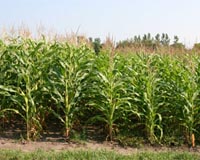 |
Washington DC (SPX) Apr 14, 2010 Agricultural Research Service (ARS) scientists are figuring out how to turn wheat straw into ethanol "gold," and learning more about the bacteria that can "infect" ethanol plants and interfere with fuel production. At the ARS National Center for Agricultural Utilization Research (NCAUR) in Peoria, Ill., ARS chemist Badal Saha conducted a 5-year study that examined whether wheat straw-a crop residue left over after the grain has been harvested-could have commercial potential for cellulosic ethanol production. Saha found he could access and ferment almost all the plant sugars in the biofeedstock when it was pretreated with alkaline peroxide and then broken down by enzymes. This process released even hard-to-reach sugars in plant cell walls, which significantly boosted the overall ethanol output to around 93 gallons per ton of wheat straw. But the same environments that facilitate fermentation can also nurture microorganisms that "infect" ethanol production facilities and disrupt output. ARS geneticist Tim Leathers collected bacteria from samples at commercial ethanol facilities, including a wet-mill facility that had never been dosed with antibiotics and a dry-grind facility that periodically dosed with antibiotics after bacterial outbreaks. He found that most of the bacterial isolates he collected from both facilities were different types of lactic acid bacteria. Meanwhile, ARS microbiologist Ken Bischoff developed a model for simulating bacterial contamination and infection. He found that when test cultures were inoculated with Lactobacillus fermentum-one of the most common sources of bacterial infections in ethanol plants-ethanol yields decreased by 27 percent. Sometimes the "infection" could be cured with antibiotics, but he also found one bacterial strain that was already resistant to treatment. Results from this research have been published in several journals, including Biotechnology and Bioengineering, the Journal of Biobased Materials and Bioenergy, and the Journal of Industrial Microbiology and Biotechnology. Read more about this research in the April 2010 issue of Agricultural Research magazine. ARS is the principal intramural scientific research agency of the U.S. Department of Agriculture (USDA). This research supports the USDA priority of developing new sources of bioenergy.
Share This Article With Planet Earth
Related Links Agricultural Research Service (ARS) Bio Fuel Technology and Application News
 More Economical Process For Making Ethanol From Nonfood Sources
More Economical Process For Making Ethanol From Nonfood SourcesSan Francisco CA (SPX) Mar 31, 2010 Scientists in Wisconsin are reporting discovery of a way to lower the cost of converting wood, corn stalks and leaves, switch grass, and other non-food biomass materials into ethanol fuel. They describe their process, which reduces amounts of costly enzymes needed to break down tough fibrous cellulose matter in biomass for fermentation into alcohol, here today at the 239th National Meeting of th ... read more |
|
| The content herein, unless otherwise known to be public domain, are Copyright 1995-2010 - SpaceDaily. AFP and UPI Wire Stories are copyright Agence France-Presse and United Press International. ESA Portal Reports are copyright European Space Agency. All NASA sourced material is public domain. Additional copyrights may apply in whole or part to other bona fide parties. Advertising does not imply endorsement,agreement or approval of any opinions, statements or information provided by SpaceDaily on any Web page published or hosted by SpaceDaily. Privacy Statement |